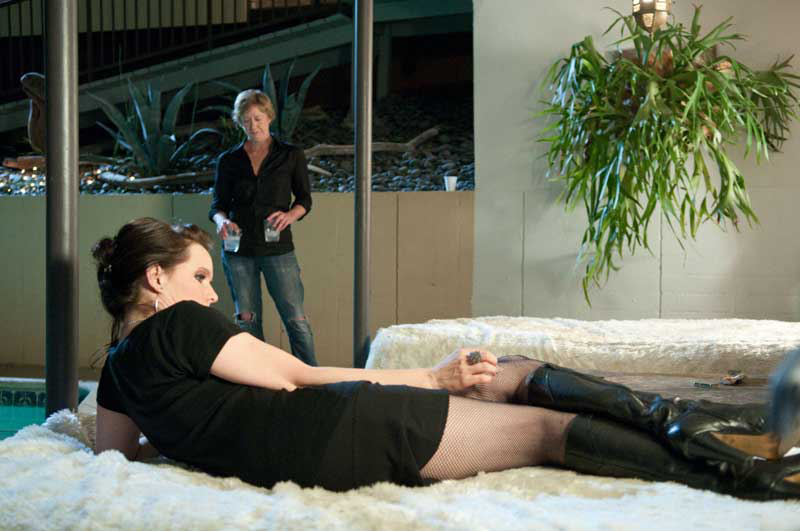|
The Paliament Film Collective's (Partial) Canon of Lesbian Cinema |
||||
 |
||||
M.J. and Iris (V.S. Brodie and Guinevere Turner). Still from The Owls (dir. Cheryl Dunye, 2010). Used with permission from the Parliament Film Collective. |
||||
A Lesbian Collective Aesthetic:
Making and Teaching The Owls
Page 2 of 6
For instance, while making The Owls, Campbell (she goes by this name only and was previously known as Inge Blackman), our “sound-man” (a talented British director in her own right, i.e. her B.D. Women, 1995, is “a celebration of the history and culture of Black lesbians”) noted in one of her talking-head interviews (the crew as well as the cast were interviewed across the production to create documentary footage that addresses the themes and meta-themes of the film: queer cinema and identity, lesbian culture, aging, and the like) that as an English-woman of Caribbean descent she found it important that the two black characters in the film (Cheryl Dunye and Skyler Cooper, playing Carol and Skye respectively), were not named as black in the screenplay. The B-team (shooting the “documentary” component of the film), discussed (on camera) with Campbell what she saw as the productive potential for unknowing or unnaming in this queer post-identity move and movie. But this was only the beginning of cross-generational, cross-racial collective aesthetic because this documentary footage of Campbell, stating this concern, is cut into that very narrative film where race is not named, thereby naming it. Hence in the collective’s production process (and the record of it inscribed into the film), a difficult conversation about how to understand black lesbian history, visibility, and identity is raised, maintained, and left open to be addressed in the film’s text and later teaching, and not simple as a political question, but as a formal one as well. Unlike more traditional narratives where contradictions (in production and theme) are stylized and smoothed away, our collective lesbian aesthetic seeks to let them be seen, as should teaching based upon it.
This is the first example of what will be my focus throughout: the lesbian collective aesthetic of The Owls lies in the way in which it was made as much as in its content or form, or perhaps more to the point, the way it is made is visible in its experimental content and form. This lesbian aesthetic, much focused upon, discussed and recorded when making the film, can be revisited when viewing the film (as well as the other queer/feminist films listed in our Partial Canon), in effect continuing the aesthetic outside the film’s text via critical, feminist reception and pedagogy. Method and form both hold and produce lesbian content, and because these may be new, radical, and complex, audiences need guidance to get it. For those who watch or teach cinema, but have not yet had the opportunity to make it, the careful work of envisioning, conceptualizing, and then actually constructing film, scene by scene, player by player, is often obscured (by transparent style) or obscure (because most viewers take legitimate pleasure in watching all-consuming, easily unrolling stories). By using this opportunity to allow some of the players who made this film to discuss their own work and influences, I hope to model a (queer/feminist) method for discussing, understanding, and teaching lesbian cinema. Given that many of the readers of this essay may not have made film themselves, I will conclude with some framing questions focused upon keeping the often elusive production process in sight.
Lesbian Identity, Lesbian Cinema, Lesbian Aesthetics
We made The Owls in the summer of 2009, shooting for one week in Los Angeles, editing over the fall, and premiering at the Berlin International Film Festival in February 2010. The film was made for $21,000, acquired through the collected contributions of its six producers at $3,000 each, and an advance of the same figure from our sales agents, the queer-run Collaborative.2 To be clear: Hollywood films shoot for months, most indie films take several weeks at minimum, and most movies need millions of dollars to move from page to screen. How did we do it with next to nothing? Critically, the entire cast and crew worked for free under a “favored nations” agreement where everyone got $100 per day (from producers to production assistants) as a deferral (to be paid if and when the initial investment of $21,000 is recouped). I emphasize our unique economic model for three reasons. First, we hope others will use it, since it allows women, queers, people of color, and marginalized others to make cinema because and when we want to, within our own communities, and about our distinct needs and interests. Second, it is only recently possible to do what we have done, given the new accessibility of inexpensive, professional quality equipment and, in our case, a crew of sixty queers who are professional (or aspiring) film artists—this a recent phenomenon itself enabled by feminist/queer film education, scholarship, and community. And finally, it serves as a partial but critical explanation of the (lesbian) collective forms or aesthetic we chose and made, the main preoccupation of this article.
Copyright © 2014. All rights reserved.